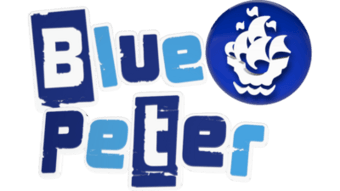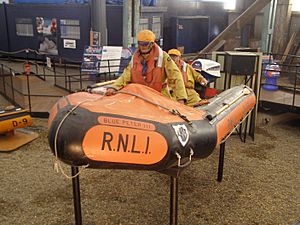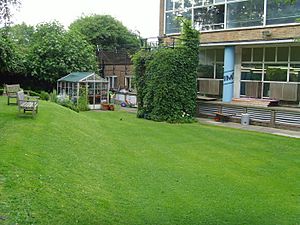Blue Peter facts for kids
Quick facts for kids Blue Peter |
|
|---|---|

The Blue Peter logo (2011–present)
|
|
| Genre |
|
| Created by | John Hunter Blair |
| Presented by | Lindsey Russell (2013–) Richie Driss (2019–) Mwaka Mudenda (2020–) Adam Beales (2020–) (See full list) |
| Country of origin | United Kingdom |
| Original language(s) | English |
| No. of episodes | 5,134 (as of 24 September 2020) |
| Production | |
| Production location(s) | dock10 studios (2011–current) |
| Running time | 15 minutes (1958–1960s) 25 minutes (1960s–2008) 35 minutes (2005–2006; CBBC Channel Extension) 24 minutes (2008–2011) 28 minutes (2012–) 60 minutes (Birthday specials and documentaries) |
| Release | |
| Original network | BBC Television Service (1958–1960) BBC TV (1960–1964) BBC1 (1964–2012) CBBC (1985–present) CBBC HD (2013–) |
| Original release | 16 October 1958 – present |
Blue Peter is a British TV show for children that started way back in 1958. It's the longest-running children's TV show in the world! For many years, it was made in London at BBC Television Centre. But in 2011, the show moved north to dock10 studios in Salford, Greater Manchester. You can watch it live on the CBBC channel today.
The show was created by John Hunter Blair and later developed by a BBC team led by Biddy Baxter. She was the editor from 1965 to 1988. Many presenters have hosted the show over the years. Right now, it's hosted by Lindsey Russell, Richie Driss, Mwaka Mudenda, and Adam Beales.
Blue Peter uses a nautical (boat-themed) name and style. It's like a magazine show, full of fun and facts! You'll see challenges for viewers and presenters, cool competitions, interviews with famous people, and tips for making arts and crafts from things you have at home. The show has a special garden, first in London and now in Salford, which they use for outdoor activities. Famous pets have also been part of the show, like dogs Petra, Shep, and Goldie, plus tortoises, cats, and parrots. Blue Peter is a big part of British culture because it's been on for so long.
Contents
What's on Blue Peter?
Blue Peter covers many different topics. Most shows are live, but they often include a filmed report. You might also see a cool demonstration in the studio, or a music or dance performance. The show is famous for its "makes," which are step-by-step guides to build something useful or cook food. This is where the famous phrase "Here's one I made earlier" comes from! Presenters often show a perfect, finished version of what they are making. Viewers also send in letters and pictures, which are often shown on the programme.
More than 5,000 episodes have been made since 1958. Almost every episode from 1964 onwards is saved in the BBC archives. This is rare for shows from that time! The editor, Biddy Baxter, made sure every episode was recorded and kept. Many moments from Blue Peter's history, especially when things went a bit wrong, have become famous in British culture.
Meet the Presenters and Friends
The very first presenters of Blue Peter were Christopher Trace and Leila Williams in October 1958. Since then, there have been 37 more! Lindsey Russell joined in 2013, and Richie Driss became the 38th presenter in May 2019. Then came Mwaksy Mudenda as the 39th presenter in June 2019, followed by Adam Beales as the 40th in September 2020.
Other important people on the show include:
- George Cansdale, the first on-screen vet.
- Percy Thrower, the gardening expert from 1974 to 1987. He even got a special Gold Blue Peter badge!
- Margaret Parnell, who created almost all the "makes" from 1963 until 2001.
- Alex Leger, a director/producer who worked on the show for a very long time, from 1975 to 2011. He even wrote a book about his time there!
Blue Peter Pets
The Blue Peter pets are animals that regularly appear on the show. They include dogs, cats, parrots, and tortoises. Some of the most famous dogs were Petra, Shep, and Goldie.
Recent pets include:
- Two cats, Socks and Cookie.
- A tortoise named Shelley.
- Barney, a red setter-dachshund cross, who joined in 2009.
- Lucy, a golden retriever, who sadly passed away in 2011.
- Iggy, a trained Guide Dog, who joined in 2014.
- Henry, a Beagle-Basset Hound cross, who joined in 2019.
The pets are looked after by the show's vet, Dr Rory Cowlam.
Blue Peter Editors
The editor is in charge of the show. Here are the people who have been Blue Peter's editor:
- Biddy Baxter (1965–1988)
- Lewis Bronze (1988–1996)
- Oliver Macfarlane (1996–1999)
- Steve Hocking (1999–2003)
- Richard Marson (2003–2007)
- Tim Levell (2007–2013)
- Ewan Vinnicombe (2013–2019)
- Ellen Evans (2019–present)
The Blue Peter Garden
Since the 1970s, Blue Peter has had its own garden. The first garden was designed by British gardener Percy Thrower in 1974, behind the BBC Television Centre in London. It had a pond with goldfish, a vegetable patch, and a greenhouse. The garden was also used to remember the show's pets and special events. A statue of the dog Petra was placed there after she passed away in 1977. The remains of George the Tortoise were buried there in 2004.
In 1983, the garden was unfortunately vandalised. There was a rumour that some famous footballers were involved when they were teenagers, but they denied it.
When the show moved to Salford in 2011, parts of the first garden, like sculptures and the pond, were moved to the new studio location. A Blue Peter time capsule buried in London was also brought to the new garden. It was supposed to be opened in 2029 but was accidentally dug up in 2017! The second Blue Peter garden was officially opened in 2012 by The Princess Royal. It's still used for outdoor broadcasts and live events today.
Blue Peter Badges
Children (and even some adults!) who appear on the show or do something amazing can earn a special Blue Peter badge. These badges let holders get free entry into many visitor attractions across the UK. In 2006, this was paused for a bit because some badges were being sold online. Now, badge winners get a special "Blue Peter Badge Card" to prove they are the real owners.
Presenters almost always wear their badge. If they can't (like when wearing a life jacket), they use a sticker with the Blue Peter ship logo instead. Large stickers of the ship are also put on vehicles used by presenters during filming.
There are different types of badges for different achievements:
- Blue badges: The standard badge for appearing on the show or doing something notable.
- Silver badges: For sending in a letter or poem if you already have a blue badge.
- Green badges: For contributions about nature or the environment.
- Gold badges: The rarest and most special badge, given for amazing achievements.
- Orange badges: For competition winners or runners-up.
- Purple badges: For reviewing the show on the Blue Peter website.
- Sport badge: For inspiring someone to try a new sport (awarded in summer).
- Diamond Badge: A special badge for the show's 60th birthday in 2018.
Yearly Celebrations
The show celebrates many annual events, like Chinese New Year, St David's Day, Shrove Tuesday, Mothering Sunday, Guy Fawkes Night, and Christmas. Christmas is a very special show with lots of traditions!
Shrove Tuesday
Usually, the newest presenter tries to make and perfectly toss a pancake!
Mothering Sunday
The show often teaches viewers how to make their own Mother's Day card or present.
Guy Fawkes Night
This episode usually tells the story of Guy Fawkes and the Gunpowder Plot. Presenters also share tips for staying safe with fireworks and bonfires.
Christmas
The traditional Christmas show often starts with a brass band playing "Good King Wenceslas" while showing viewers' homemade Christmas cards. They light the last candle on the Advent Crown and feature the Christmas manger figures to remind everyone of the Nativity story. There's usually a last-minute Christmas "make" or a song and dance. The show ends with the Chalk Farm Salvation Army Band and children singing a Christmas carol around the Blue Peter Christmas tree. Sometimes, there's even a Christmas play! Many of these traditions have been part of the show for decades.
Charity Appeals

A big part of Blue Peter is the yearly charity appeal. Viewers are asked to collect items that can be recycled or sold to raise money for a good cause. For example, in 1973–74, they asked people to donate postage stamps to help with famine relief in Ethiopia. These appeals usually help a UK charity in odd-numbered years and an international charity in even-numbered years.
One popular way to raise money is the "Blue Peter Bring And Buy Sales," where people sell their old items. In recent years, they've collected old clothes for Oxfam, mobile phones for ChildLine, and shoes for UNICEF to help children in Malawi. The 2007 appeal, "Disc Drive," asked for unwanted CDs and DVDs to help Barnardo's.
During appeals, the total money or items collected are shown on a "totaliser," a display that lights up to show how much has been raised. Sometimes, if the first goal is met, they set a new, higher goal!
In 2008, the "Mission Nutrition" appeal aimed to provide better food for children in the UK, Bangladesh, and South Africa. They even held the world's biggest bring and buy sale! In 2009, the "Send a Smile Appeal" asked children to collect unwanted T-shirts to be used as surgical gowns for children needing operations.
It's estimated that since the first appeal, Blue Peter has raised over £100 million for charity! In 2018, the "Bring and Buy Sales" returned to help BBC Children in Need.
Blue Peter Book Awards
Blue Peter also helps promote the Blue Peter Book Awards. These are special awards given every year for the best children's books, which started in 2000.
Time Capsules
One of the most famous parts of Blue Peter is its time capsules. The tradition began in 1971 when the first capsule was buried. It was meant to show future generations what life was like back then. Viewers even helped choose what went inside! Since then, more time capsules have been buried and opened.
1971–2000 Capsule
The first time capsule was buried by presenters Valerie Singleton, John Noakes, and Peter Purves outside the BBC Television Centre. It held things like a Blue Peter annual, new decimal coins, and photos of the presenters. The capsule had to be moved in 1984 because of building work. When it was dug up in 2000, some items were damaged by water, but most were in good shape.
1984–2000 Capsule
A second capsule was buried next to the first one in 1984. It contained hairs from Goldie the Labrador, a recording of the show's theme tune, and video of Petra's statue being moved. This capsule was also dug up in 2000.
1998–2017/2050 (The Millennium Time Capsule)
The third capsule was buried in 1998 under the Millennium Dome. It included Blue Peter items, Teletubby dolls, and a football. This capsule was meant to be opened in 2050, but it was accidentally dug up and damaged by builders in 2017! It was then restored and will be stored in the National Archives until 2050.
2000–2029 Capsule
After the first two capsules were opened in 2000, a fourth one was buried in the Blue Peter garden. It included a Blue Peter book, videos of the show's best bits from 1999, and photos of the presenters and crew. Presenters Matt Baker, Simon Thomas, Katy Hill, and Konnie Huq also added their own items. This capsule is due to be opened in 2029.
2018–2038 (The Diamond Time Capsule)
In 2018, for their 60th anniversary, a new time capsule was announced. Viewers could suggest what to put inside for the first time! This capsule is also stored in the National Archives, not buried. It was placed there by a competition winner and several past and present presenters.
Blue Peter Books
Since 1964, Blue Peter has published a book every year, usually around Christmas. These books are like annuals, featuring highlights from the past year's shows, special guests, summer trips, and the annual appeal. The style of the books hasn't changed much, though they now have more colour photos.
These books have become collector's items. The very first "Book One" is quite rare and can be worth a lot of money! Books from the 1960s and 70s are easier to find, while those from the 80s and 90s are a bit rarer. In 2011, it was announced that the annuals would be stopped due to lower sales, but they might return in the future.
Theme Tune and Logo
The Blue Peter theme tune has always been a hornpipe (a type of dance tune). It started with "Barnacle Bill" and later included parts of "Sailor's Hornpipe." Different versions of the tune have been used over the years, often updated by new musicians.
Opening Theme Music
Here are some of the composers who have created versions of the Blue Peter theme tune:
- Sidney Torch & The New Century Orchestra: 1958 to 1979
- Mike Oldfield: 1979 to 1989
- Simon Brint: 1989 to 1994 (two versions)
- The Yes/No People: 1994 to 1999
- David Arnold and the BBC Philharmonic Orchestra: 1999 to 2004
- Nial Brown: 2004 to 2006
- Dave Cooke: 2007 (two versions)
- Dobs Vye: 2008 to 2011
- Banks & Wag: 2011 – present
Closing Theme Music
For many years, the show ended with a piece of music called Drums and Fife. This was replaced by the opening theme tune in 1999, brought back in 2004, and then dropped again in 2008. Now, the closing music is the same as the opening theme.
The Blue Peter Ship Logo
The show's logo is a cool sailing ship designed by Tony Hart. Over the years, the ship's design has changed slightly, but it always looks like a sailing ship. In 1999, the ship was simplified, and in 2008, it went back to having some of its original flag details.
Opening Titles (Intro Videos)
The opening titles are the short videos at the start of the show. They have changed many times:
- 1958–1989: Showed a Blue Peter flag being lowered or clips from the episode. Presenters' names were listed by how long they had been on the show.
- 1989–1997: Used animated versions of the Blue Peter ship.
- 1997–1999: Featured clips of presenters on adventures mixed with action shots.
- 1999–2004: Introduced a "bubble ship" symbol and showed presenters with floating bubble ships.
- 2004–2006: Presenters posed as if hoisting sails on the ship, with the pets also appearing.
- 2006–2008: Showed presenters with "fact file boxes" about them and clips from past films.
- 2008–2009: Went back to a fast-moving graphic style without posing presenters.
- 2009–2011: Similar to 2008, but included pictures and first names of the presenters.
- 2011–2013: Showed presenters playing with objects that changed, like an adventure box or a globe. The logo was put into a blue circle.
- 2013–2015: Used clips of past show activities.
- 2015–present: Features colourful graphics with rainbow lines and floating letters and the ship logo.
Closing Credits
The closing credits show who made the programme.
- 1958–1992: Credits appeared over the last moments of the show, often with shots of the pets.
- 1992–2003: Credits scrolled across the bottom of the screen.
- 2004–2007: Credits flashed up with a photo of a recent Blue Peter badge winner and a presenter's voice introducing them.
- 2007–2008: Returned to showing clips of what's coming up next time, with credits over a bar at the bottom.
- 2008–present: Now, the show ends with a short five-second screen showing the Blue Peter and CBBC logos.
At Christmas, the credits often have festive drawings. If a "make" was shown, the person who created it was usually credited first.
Awards and Honours
Blue Peter has won many awards and is highly respected:
- In 2000, it was ranked 6th in a list of the "100 Greatest British Television Programmes" by the British Film Institute.
- In 1992, Blue Peter won a BAFTA award for Best Children's Programme (Factual).
- In 2008, it was nominated for the BAFTA Children's Kids Vote Award.
- There's even an Asteroid named after it: 16197 Bluepeter! It was discovered on January 7, 2000, the same day the 1971 and 1984 Blue Peter time capsules were dug up.
Images for kids
-
The specially painted Blue Peter British Airways Boeing 757 landing at London Heathrow Airport






